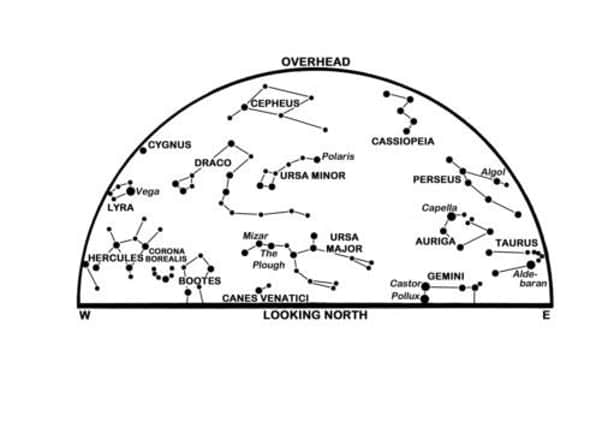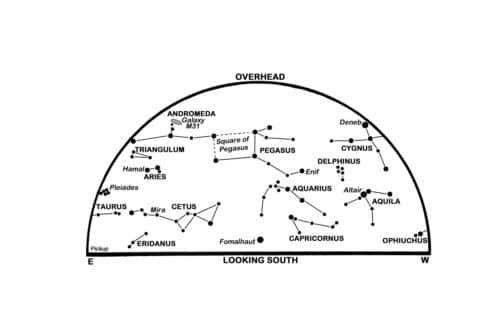The Sky in October: Mars meets Regulus


• The maps apply at 23.00 BST on the 1st, 22.00 BST (21.00 GMT) on the 16th and at 20.00 GMT on the 31st. Summer time ends at 02.00 BST on the 27th when clocks are set back one hour to 01.00 GMT.
Sweeping close to Mars is Comet ISON which remains dim at present but may yet brighten to become an impressive sight later in the year
Advertisement
Hide AdAdvertisement
Hide AdThe Summer Triangle of Vega, Altair and Deneb still looms high on the meridian at dusk but has tumbled westwards by our star map times. Trailing behind it is Delphinus where a nova flared in August.


That stellar outburst was still just visible through binoculars last week but was perhaps on the verge of plunging much fainter as is becomes shrouded in dust forming in the wake of the explosion.
Our charts show the Square of Pegasus approaching the meridian as the Plough rotates counterclockwise below Polaris in the north and the “W” of Cassiopeia nears the zenith. Taurus and the Pleiades are climbing in the east while Gemini is rising in the north-east with the Twins, Castor and Pollux, one above the other.
Jupiter stands 8° below and to the right of Pollux and rises less than 30 minutes after our map times, climbing to prominence high in the south-south-east to south before dawn. The planet creeps 2° eastwards during October, passes only 7 arcminutes north of the magnitude 3.5 star Delta Geminorum on Friday and is above the Moon on the 26th. Jupiter improves from magnitude -2.2 to -2.4 this month and swells from 38 to 41 arcseconds wide if viewed telescopically.
Our other pre-dawn planet, Mars, stands above-left of the Moon this morning and again on the 30th. Rising for Edinburgh in the east-north-east at 02:27 BST today and by 01:18 GMT on the 31st, it is climbing well up into the south-east before dawn.
From 9° above-right of Leo’s leading star Regulus this morning, it speeds eastwards to pass 1.0° north of Regulus late on the 14th and lie 9° below-left of the star at month’s end. It improves slightly from magnitude 1.6 to 1.5 but remains just fainter than the magnitude 1.4 of Regulus. Note, though, the contrast in appearance with Mars being steady and reddish while Regulus is bluish-white and twinkling. Through a telescope, the planet’s tiny ochre disk is 4 to 5 arcseconds wide.
Comet ISON remains something of an enigma. Discovered just over a year ago when it lay beyond the orbit of Jupiter, it has been diving towards the Sun on a path that carries it 1,100,000 km above the Sun’s surface on 28 November.
Some predictions have it as bright as the full moon at that point, albeit swamped in the Sun’s glare. In fact, its brightening has been slower than most were expecting and it was still a dim 12th magnitude object last week. Hopes remain that it will be a naked-eye object in mid-November and again during December when it may well sport an impressive tail.
Advertisement
Hide AdAdvertisement
Hide AdIts orbit takes it within 10.5 million km of Mars today and it is already being observed by spacecraft at the planet. It stands 2.0° above-left of Mars in our morning sky tomorrow, moving to lie within 0.9° of Mars on the 18th and 6° below-left of the planet by the 31st. We can only hope that it might be visible through binoculars by the month’s end.
An unfortunate fact concerning our autumn sky is that planets that lie to the east of the Sun are hugging our horizon at sunset. Take Venus, for example. As seen from Edinburgh at sunset today, the brilliant magnitude -4.2 evening star stands 135 million km away and 45° away from the Sun but is only 5° high in the south-west. It sets 53 minutes later and should be obvious as the twilight fades, but only if our horizon is clear.
Contrast this with Australia where Venus is a stunning object 43° high in the W at sunset and remains visible for almost four hours.
The reason, of course, is that the planets never stray far from the ecliptic, the Sun’s apparent annual path against the stars. At present the ecliptic slants low across Scotland’s south-western sky at nightfall as it traces the Sun’s southerly motion until midwinter.
By the 31st, Venus stands 5° above Edinburgh’s south-south-western horizon at sunset, shines a little brighter at magnitude -4.4 and is 6° below-right of the Sun’s midwinter position against the stars.
As Venus approaches to 101 million km this month, its telescopic diameter swells from 19 to 25 arcseconds while the dazzling sunlit part of its disk changes from 63 per cent to 50 per cent. Look for the planet 4° below the young crescent Moon on the 8th and 1.5° above the red supergiant Antares in Scorpius on the 16th.
We have no chance of seeing Saturn or Mercury which are both fainter and closer to the Sun in the evening sky than Venus.
This month the Sun tracks 11° southwards as sunrise/sunset times for Edinburgh change from 07:16/18:48 BST (06:16/17:48 GMT) on the 1st to 07:18/16:34 GMT on the 31st. Nautical twilight persists for about 82 minutes at dawn and dusk. The Moon is new on the 4th, at first quarter on the 12th, full on the 19th and at last quarter on the 27th.
Advertisement
Hide AdAdvertisement
Hide AdThe southern 76 per cent of the Moon’s disk slips through the fringe of the Earth’s shadow on the night of the 18th/19th to cause a penumbral lunar eclipse. Although only a slight dimming may be noticed, at least the Moon is well placed being in Pisces in the middle of our southern sky. The eclipse lasts from 22:51 to 02:50 BST.